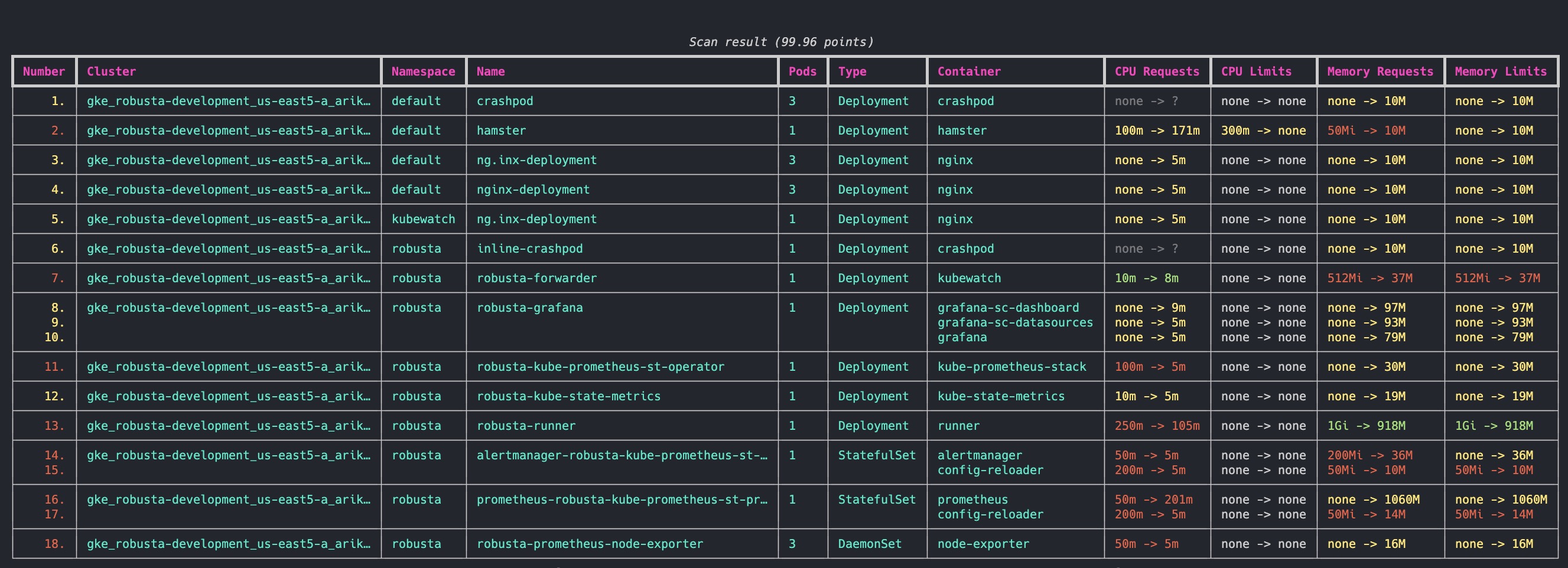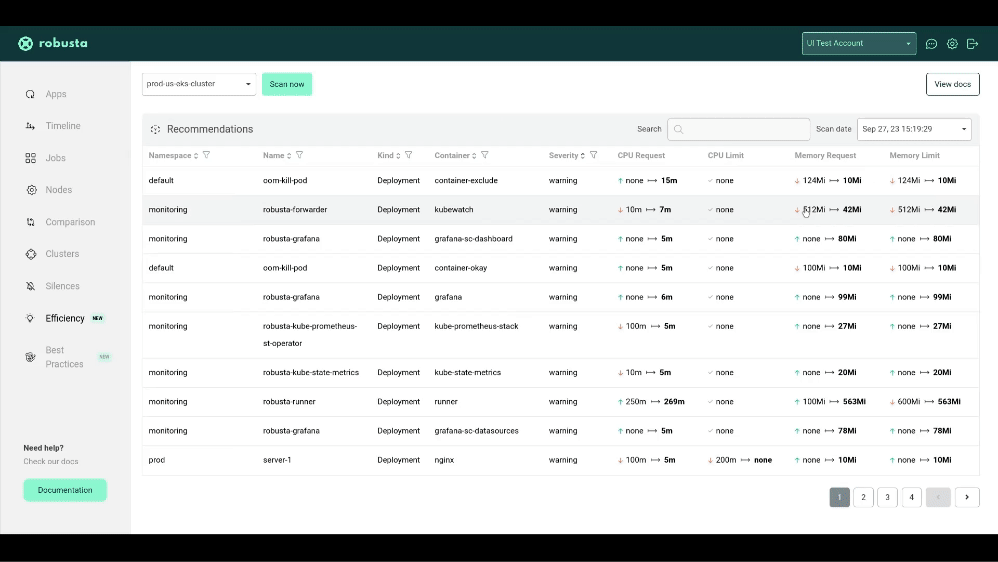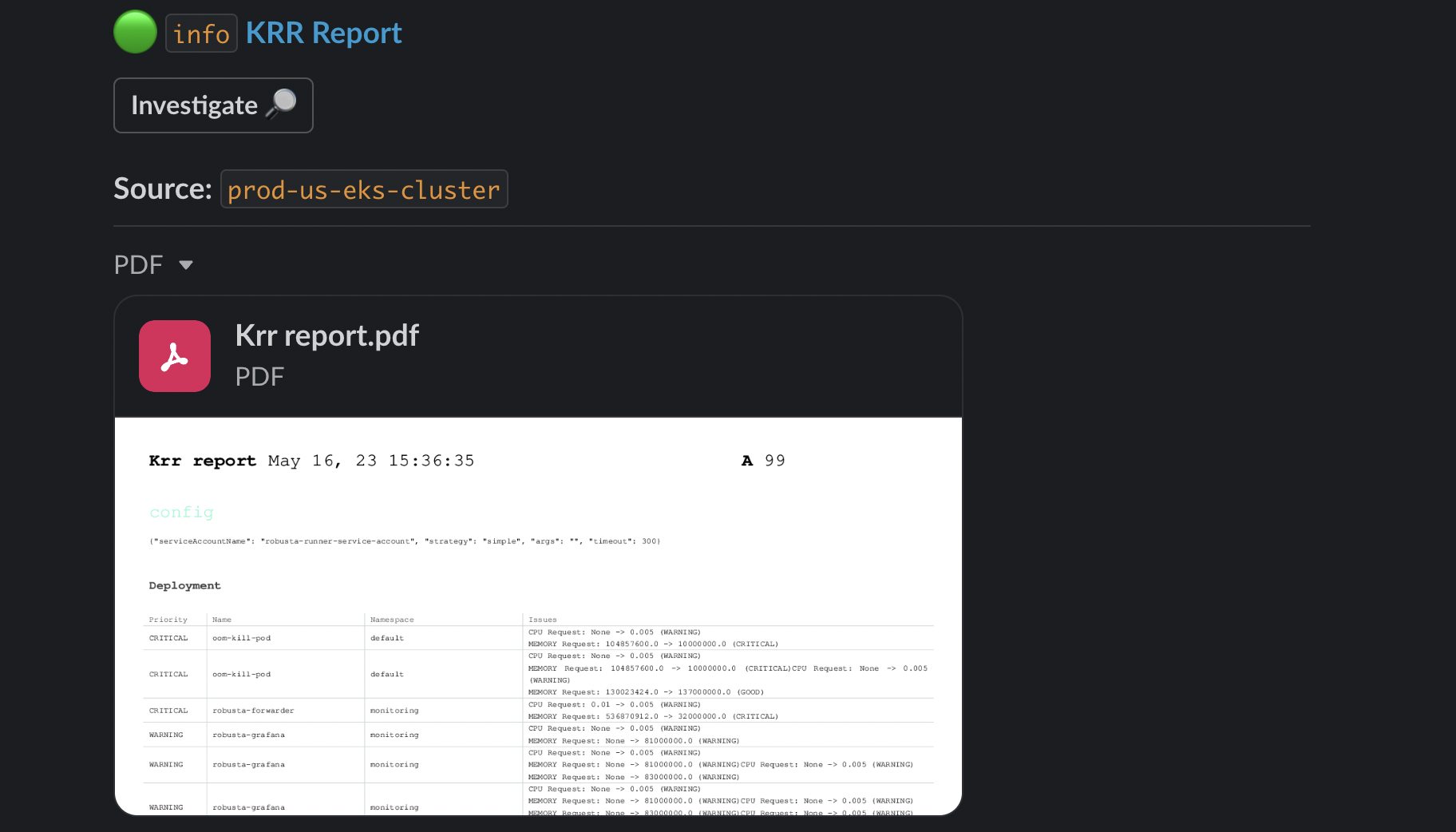Prometheus-based Kubernetes Resource Recommendations
Installation
.
Usage
·
How KRR works
.
Slack Integration
Report Bug
·
Request Feature
·
Support
Robusta KRR (Kubernetes Resource Recommender) is a CLI tool for optimizing resource allocation in Kubernetes clusters. It gathers pod usage data from Prometheus and recommends requests and limits for CPU and memory. This reduces costs and improves performance.
View Instructions for: Prometheus, Thanos, Victoria Metrics, Google Managed Prometheus, Amazon Managed Prometheus, Azure Managed Prometheus, Coralogix,Grafana Cloud and Grafana Mimir
View instructions for: Seeing recommendations in a UI, Sending recommendations to Slack, Setting up KRR as a k9s plugin
- No Agent Required: Run a CLI tool on your local machine for immediate results. (Or run in-cluster for weekly Slack reports.)
- Prometheus Integration: Get recommendations based on the data you already have
- Explainability: Understand how recommendations were calculated
- Extensible Strategies: Easily create and use your own strategies for calculating resource recommendations.
- Free SaaS Platform: See why KRR recommends what it does, by using the free Robusta SaaS platform.
- Future Support: Upcoming versions will support custom resources (e.g. GPUs) and custom metrics.
According to a recent Sysdig study, on average, Kubernetes clusters have:
- 69% unused CPU
- 18% unused memory
By right-sizing your containers with KRR, you can save an average of 69% on cloud costs.
Read more about how KRR works and KRR vs Kubernetes VPA
KRR requires Prometheus 2.26+, kube-state-metrics & cAdvisor.
Which metrics does KRR need?
No setup is required if you use kube-prometheus-stack or Robusta's Embedded Prometheus.If you have a different setup, make sure the following metrics exist:
container_cpu_usage_seconds_totalcontainer_memory_working_set_byteskube_replicaset_ownerkube_pod_ownerkube_pod_status_phase
Note: If one of last three metrics is absent KRR will still work, but it will only consider currently-running pods when calculating recommendations. Historic pods that no longer exist in the cluster will not be taken into consideration.
Brew (Mac/Linux)
- Add our tap:
brew tap robusta-dev/homebrew-krr- Install KRR:
brew install krr- Check that installation was successful:
krr --help- Run KRR (first launch might take a little longer):
krr simpleWindows
You can install using brew (see above) on WSL2, or install from source (see below).
Airgapped Installation (Offline Environments)
You can download pre-built binaries from Releases or use the prebuilt Docker container. For example, the container for version 1.8.3 is:
us-central1-docker.pkg.dev/genuine-flight-317411/devel/krr:v1.8.3
We do not recommend installing KRR from source in airgapped environments due to the headache of installing Python dependencies. Use one of the above methods instead and contact us (via Slack, GitHub issues, or email) if you need assistance.
From Source
- Make sure you have Python 3.9 (or greater) installed
- Clone the repo:
git clone https://github.com/robusta-dev/krr- Navigate to the project root directory (
cd ./krr) - Install requirements:
pip install -r requirements.txt- Run the tool:
python krr.py --helpNotice that using source code requires you to run as a python script, when installing with brew allows to run krr.
All above examples show running command as krr ..., replace it with python krr.py ... if you are using a manual installation.
Setup KRR for...
- Google Cloud Managed Prometheus
- Azure Managed Prometheus
- Amazon Managed Prometheus
- Coralogix Managed Prometheus
- Grafana Cloud Managed Prometheus
- Grafana Mimir
Basic usage
krr simpleTweak the recommendation algorithm (strategy)
Most helpful flags:
--cpu-minSets the minimum recommended cpu value in millicores--mem-minSets the minimum recommended memory value in MB--history_durationThe duration of the Prometheus history data to use (in hours)
More specific information on Strategy Settings can be found using
krr simple --helpGiving an Explicit Prometheus URL
If your Prometheus is not auto-connecting, you can use kubectl port-forward for manually forwarding Prometheus.
For example, if you have a Prometheus Pod called kube-prometheus-st-prometheus-0, then run this command to port-forward it:
kubectl port-forward pod/kube-prometheus-st-prometheus-0 9090Then, open another terminal and run krr in it, giving an explicit Prometheus url:
krr simple -p http://127.0.0.1:9090Run on specific namespaces
List as many namespaces as you want with -n (in this case, default and ingress-nginx)
krr simple -n default -n ingress-nginxRun on workloads filtered by label
Use a label selector
python krr.py simple --selector 'app.kubernetes.io/instance in (robusta, ingress-nginx)'Override the kubectl context
By default krr will run in the current context. If you want to run it in a different context:
krr simple -c my-cluster-1 -c my-cluster-2Customize output (JSON, YAML, and more
Currently KRR ships with a few formatters to represent the scan data:
table- a pretty CLI table used by default, powered by Rich libraryjsonyamlpprint- data representation from python's pprint librarycsv_export- export data to a csv file in the current directory
To run a strategy with a selected formatter, add a -f flag:
krr simple -f jsonFor JSON output, add --logtostderr so no logs go to the result file:
krr simple --logtostderr -f json > result.jsonFor YAML output, do the same:
krr simple --logtostderr -f yaml > result.yamlCentralized Prometheus (multi-cluster)
See below on filtering output from a centralized prometheus, so it matches only one cluster
Prometheus Authentication
KRR supports all known authentication schemes for Prometheus, VictoriaMetrics, Coralogix, and other Prometheus compatible metric stores.
Refer to krr simple --help, and look at the flags --prometheus-url, --prometheus-auth-header, --prometheus-headers --prometheus-ssl-enabled, --coralogix-token, and the various --eks-* flags.
If you need help, contact us on Slack, email, or by opening a GitHub issue.
Debug mode
If you want to see additional debug logs:krr simple -vRobusta KRR uses the following Prometheus queries to gather usage data:
-
CPU Usage:
sum(irate(container_cpu_usage_seconds_total{{namespace="{object.namespace}", pod="{pod}", container="{object.container}"}}[{step}])) -
Memory Usage:
sum(container_memory_working_set_bytes{job="kubelet", metrics_path="/metrics/cadvisor", image!="", namespace="{object.namespace}", pod="{pod}", container="{object.container}"})
Need to customize the metrics? Tell us and we'll add support.
Get a free breakdown of KRR recommendations in the Robusta SaaS.
By default, we use a simple strategy to calculate resource recommendations. It is calculated as follows (The exact numbers can be customized in CLI arguments):
-
For CPU, we set a request at the 99th percentile with no limit. Meaning, in 99% of the cases, your CPU request will be sufficient. For the remaining 1%, we set no limit. This means your pod can burst and use any CPU available on the node - e.g. CPU that other pods requested but aren’t using right now.
-
For memory, we take the maximum value over the past week and add a 15% buffer.
Find about how KRR tries to find the default Prometheus to connect here.
| Feature 🛠️ | Robusta KRR 🚀 | Kubernetes VPA 🌐 |
|---|---|---|
| Resource Recommendations 💡 | ✅ CPU/Memory requests and limits | ✅ CPU/Memory requests and limits |
| Installation Location 🌍 | ✅ Not required to be installed inside the cluster, can be used on your own device, connected to a cluster | ❌ Must be installed inside the cluster |
| Workload Configuration 🔧 | ✅ No need to configure a VPA object for each workload | ❌ Requires VPA object configuration for each workload |
| Immediate Results ⚡ | ✅ Gets results immediately (given Prometheus is running) | ❌ Requires time to gather data and provide recommendations |
| Reporting 📊 | ✅ Detailed CLI Report, web UI in Robusta.dev | ❌ Not supported |
| Extensibility 🔧 | ✅ Add your own strategies with few lines of Python | |
| Explainability 📖 | ✅ See graphs explaining the recommendations | ❌ Not supported |
| Custom Metrics 📏 | 🔄 Support in future versions | ❌ Not supported |
| Custom Resources 🎛️ | 🔄 Support in future versions (e.g., GPU) | ❌ Not supported |
| Autoscaling 🔀 | 🔄 Support in future versions | ✅ Automatic application of recommendations |
| Default History 🕒 | 14 days | 8 days |
Prometheus, Victoria Metrics and Thanos auto-discovery
By default, KRR will try to auto-discover the running Prometheus Victoria Metrics and Thanos. For discovering Prometheus it scans services for those labels:
"app=kube-prometheus-stack-prometheus"
"app=prometheus,component=server"
"app=prometheus-server"
"app=prometheus-operator-prometheus"
"app=rancher-monitoring-prometheus"
"app=prometheus-prometheus"For Thanos its these labels:
"app.kubernetes.io/component=query,app.kubernetes.io/name=thanos",
"app.kubernetes.io/name=thanos-query",
"app=thanos-query",
"app=thanos-querier",And for Victoria Metrics its the following labels:
"app.kubernetes.io/name=vmsingle",
"app.kubernetes.io/name=victoria-metrics-single",
"app.kubernetes.io/name=vmselect",
"app=vmselect",If none of those labels result in finding Prometheus, Victoria Metrics or Thanos, you will get an error and will have to pass the working url explicitly (using the -p flag).
Scanning with a Centralized Prometheus
If your Prometheus monitors multiple clusters we require the label you defined for your cluster in Prometheus.
For example, if your cluster has the Prometheus label cluster: "my-cluster-name", then run this command:
krr.py simple --prometheus-label cluster -l my-cluster-nameYou may also need the -p flag to explicitly give Prometheus' URL.
Azure Managed Prometheus
For Azure managed Prometheus you need to generate an access token, which can be done by running the following command:
# If you are not logged in to Azure, uncomment out the following line
# az login
AZURE_BEARER=$(az account get-access-token --resource=https://prometheus.monitor.azure.com --query accessToken --output tsv); echo $AZURE_BEARERThan run the following command with PROMETHEUS_URL substituted for your Azure Managed Prometheus URL:
python krr.py simple --namespace default -p PROMETHEUS_URL --prometheus-auth-header "Bearer $AZURE_BEARER"See here about configuring labels for centralized prometheus
Amazon Managed Prometheus
For Amazon Managed Prometheus you need to add your Prometheus link and the flag --eks-managed-prom and krr will automatically use your aws credentials
python krr.py simple -p "https://aps-workspaces.REGION.amazonaws.com/workspaces/..." --eks-managed-promAdditional optional parameters are:
--eks-profile-name PROFILE_NAME_HERE # to specify the profile to use from your config
--eks-access-key ACCESS_KEY # to specify your access key
--eks-secret-key SECRET_KEY # to specify your secret key
--eks-service-name SERVICE_NAME # to use a specific service name in the signature
--eks-managed-prom-region REGION_NAME # to specify the region the Prometheus is inSee here about configuring labels for centralized prometheus
Coralogix Managed Prometheus
For Coralogix managed Prometheus you need to specify your Prometheus link and add the flag coralogix_token with your Logs Query Key
python krr.py simple -p "https://prom-api.coralogix..." --coralogix_tokenSee here about configuring labels for centralized prometheus
Grafana Cloud Managed Prometheus
For Grafana Cloud managed Prometheus you need to specify Prometheus link, Prometheus user, and an access token of your Grafana Cloud stack. The Prometheus link and user for the stack can be found on the Grafana Cloud Portal. An access token with a metrics:read scope can also be created using Access Policies on the same portal.
Next, run the following command, after setting the values of PROM_URL, PROM_USER, and PROM_TOKEN variables with your Grafana Cloud stack's Prometheus link, Prometheus user, and access token.
python krr.py simple -p $PROM_URL --prometheus-auth-header "Bearer ${PROM_USER}:${PROM_TOKEN}" --prometheus-ssl-enabledSee here about configuring labels for centralized prometheus
Grafana Mimir auto-discovery
By default, KRR will try to auto-discover the running Grafana Mimir.
For discovering Prometheus it scans services for those labels:
"app.kubernetes.io/name=mimir,app.kubernetes.io/component=query-frontend"Free UI for KRR recommendations
With the free Robusta SaaS platform you can:
- See why KRR recommends what it does
- Sort and filter recommendations by namespace, priority, and more
- Copy a YAML snippet to fix the problems KRR finds
Slack Notification
Put cost savings on autopilot. Get notified in Slack about recommendations above X%. Send a weekly global report, or one report per team.
- A Slack workspace
- Install Robusta with Helm to your cluster and configure slack
- Create your KRR slack playbook by adding the following to
generated_values.yaml:
customPlaybooks:
# Runs a weekly krr scan on the namespace devs-namespace and sends it to the configured slack channel
customPlaybooks:
- triggers:
- on_schedule:
fixed_delay_repeat:
repeat: -1 # number of times to run or -1 to run forever
seconds_delay: 604800 # 1 week
actions:
- krr_scan:
args: "--namespace devs-namespace" ## KRR args here
sinks:
- "main_slack_sink" # slack sink you want to send the report to here
- Do a Helm upgrade to apply the new values:
helm upgrade robusta robusta/robusta --values=generated_values.yaml --set clusterName=<YOUR_CLUSTER_NAME>
k9s Plugin
Install our k9s Plugin to get recommendations directly in deployments/daemonsets/statefulsets views.
Plugin: resource recommender
Installation instructions: k9s docs
Look into the examples directory for examples on how to create a custom strategy/formatter.
We use pytest to run tests.
- Install the project manually (see above)
- Navigate to the project root directory
- Install poetry (https://python-poetry.org/docs/#installing-with-the-official-installer)
- Install dev dependencies:
poetry install --group dev- Install robusta_krr as editable dependency:
pip install -e .- Run the tests:
poetry run pytestContributions are what make the open source community such an amazing place to learn, inspire, and create. Any contributions you make are greatly appreciated.
If you have a suggestion that would make this better, please fork the repo and create a pull request. You can also simply open an issue with the tag "enhancement". Don't forget to give the project a star! Thanks again!
- Fork the Project
- Create your Feature Branch (
git checkout -b feature/AmazingFeature) - Commit your Changes (
git commit -m 'Add some AmazingFeature') - Push to the Branch (
git push origin feature/AmazingFeature) - Open a Pull Request
Distributed under the MIT License. See LICENSE.txt for more information.
If you have any questions, feel free to contact support@robusta.dev or message us on robustacommunity.slack.com




